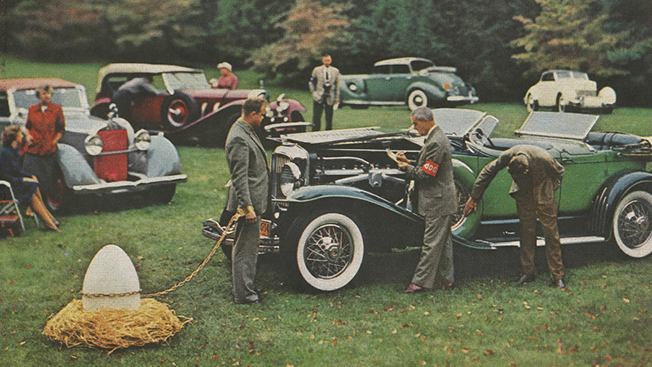Investment services have always had a tough time when it comes to marketing. For as much as we all want to amass piles of money, the idea of investing it for retirement is, well, boring as hell—at least to many people.
Banks know this, of course, and over the years they’ve tried out various techniques to get consumers’ attention. Some work and some don’t—but the one on display in the two ads here is an enduring classic: Nothing says prosperous retirement like a classic car in the garage.
When this ad appeared in 1959, Chase Manhattan
had recently become the largest bank in New York.
David Rockefeller was at the helm, and a new
skyscraper headquarters was rising downtown.
Maybe that’s why subtlety isn’t this ad’s strong suit.
Despite the obvious connection between retirement
wealth and car collecting, someone had to
stick a literal nest egg in here, just in case the
Duesenberg didn’t make the point.
“Investing is one of those unsexy topics,” said Brian Honigman, a Brooklyn, N.Y.-based marketing consultant, speaker and writer. “One way around it is using classic cars as a symbol of what you’ll be able to achieve.”
So, let’s be frank. The “you” in that calculus is pretty much presumed to be a straight white male—at least as far as this 1959 ad for Chase Manhattan Bank and its 2014 counterpart for Bank of America’s U.S. Trust are concerned. Establishment biases aside, both of these ads reach straight for a desire that seems to beat in the hearts of many red-blooded American males: the lifelong dream of owning an antique car—and the success that owning one so immediately and wordlessly conveys.
Quantifying that desire among men is a matter of anecdotal evidence. The Pinterest page “It’s a Guy Thing” is stuffed with photos of 1960s Mustangs and Maseratis. Jay Leno told Nevada magazine that hanging out with his collection of 100 cars is a “guy thing.” And a recent member survey by the Antique Automobile Club of America revealed that 82 percent of the drivers tooling the back roads in their vintage Packards and Studebakers were men. Insofar as investing, too, has historically been rather a guy thing (a study by the University of California, Davis found that men trade stocks 50 percent more often than women), it’s no surprise that banks were (and are) using vintage cars to turn the heads of men thinking about their retirement portfolios.
‘The classic car is a symbol of whether you’ve made it in your life, that long-term goal.’ |
Be it the 1958 Austin-Healey in the U.S. Trust ad or the 1930 Duesenberg in the older one, the cars “are status symbols in both instances,” Honigman said. “The classic car is a symbol of whether you’ve made it in your life, that long-term goal.” Honigman added that the manner of the sell is more of a club over the head in the 1959 ad—using a car meet as a public forum for the flashy display of wealth—versus the subtler approach of the 2014 ad. Either way, however, the manner of selling a yawn-inducing retirement trust is the same.
“Retirement should be its own reward—you don’t have to work anymore,” Honigman observed. “But if there’s a specific thing [to show] like a car, that’s more interesting.”
The presence of his kid is pivotal in softening the sell from the older ad’s message of conspicuous consumption to one of family and security. The classic cars, said Honigman, represent the wealth this man is leaving to his son.
The real point of this ad isn’t to show the classic cars in this man’s garage but sell what those cars represent— which rests in this word. “The bank is setting up a trajectory for you to live up to—an outstanding life and a legacy for your kids,” Honigman said.
While the ad doesn’t tell you that this is a ‘58 Austin-Healey (book value: $70,500 or so), it doesn’t really need to. The car looks expensive, and that’s enough to make the point.








